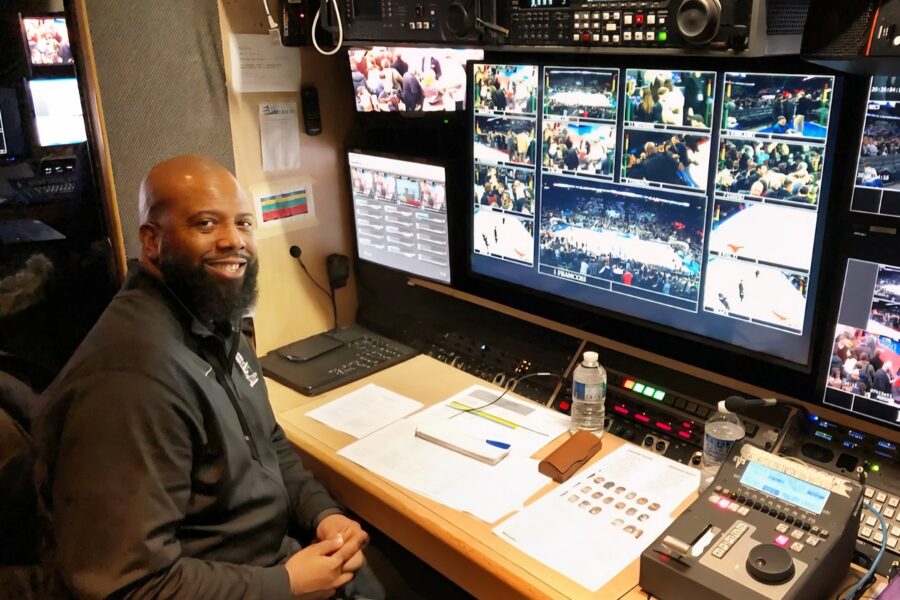
Justin Phoenix
From Camden Catholic to the NBA. Sort of.
Growing up in Williamstown, NJ and becoming a star basketball player at Camden Catholic High and Manhattan University had Justin Phoenix on a path to the NBA.
He got there. It’s just not the place in the NBA he envisioned.
Not that Phoenix is complaining.
Phoenix, 52, isn’t playing on the same hardwood with Joel Embiid, Jayson Tatum, Shai Gilgeous-Alexander or any other NBA stars.
Instead, he is in his 12th season on the NBA’s Replay Center team, which became part of game operations in 2014 and plays a major role in getting referees’ decisions correct. Phoenix serves as a replay manager.
“Just still being actively involved in basketball, seeing all the different styles,” is the best part of his job, Phoenix said last month from his home in Woodbury Heights. “I like seeing teams that weren’t really good when I started the job – like Oklahoma City – get better and now have won a championship.”
Phoenix and his replay-team colleagues watch two or three NBA games at a time. When a challenge is triggered, Phoenix and a referee who is working in Secaucus, N.J., that night will review the video of the play in question.
“We discuss what was called compared to what we see,” said Phoenix, who, before starting his current gig, played professional basketball in nine countries until 2006 and then spent seven years coaching in college. “And then we have an executive manager there who will basically confirm [or disagree with] what the call is, and then I send it [the video] to the game” for a referee to look it over.
The on-court referee [crew chief] has the final say, Phoenix said, but he/she generally sides with the decision made by the three workers in Secaucus. “If I had to put a number on it, I’d say 98 percent of the time” they concur with his group’s decision, he said.
More eyes on the action
The state-of-the-art NBA Replay Center is connected to all of the league’s arenas and is equipped with more than 100 HD monitors. The center has 23 workstations that are used by replay operators or replay managers. There are four NBA referees who rotate at the replay center.
Think of the Replay Center team as the fourth referee in an NBA game.
Operators at the center quickly find and send video clips from many angles back to the referees on the court. The clips have many different angles, and the referees review them.
Those at the Replay Center typically handle a large number of reviews, such as possessions on close out-of-bounds plays, 24-second-clock violations, flagrant fouls, and long shots that are on the border of being two or three pointers. The latter type of review accounts for more than a third of the replays in question. Another popular review: determining whether a shot was released before the buzzer at the end of a period.
Most challenges – a team must have a timeout remaining to make one – are resolved in 30 seconds or less, but a few take an interminable amount of time.
No matter how long a review takes, an accurate decision is the overwhelming result. An NBA Replay Center official estimated that of the approximately 2,200 calls that are reviewed each year, only two or three end up incorrect at the end of the process.
The biggest challenge, Phoenix said, is when one of his assigned games has several calls that are challenged.
“Sometimes, it never stops,” he said. “You go from one replay to the next replay to the next replay. You’re not watching basketball like you would as a fan, as you did when you were growing up. You’re watching it for the thing that possibly can be replayed.”
Does he miss watching the game as a fan?
“This is Year 12 for me, so you kind of get used to it,” he said. “But there are a lot of times when you have a day off and you don’t watch a lot of basketball. You have to do that [get away from it] in order to be fresh for the next time you’re in.”
Summer escape
Away from his high-pressure job, Phoenix travels in the offseason and spends a lot of his summer on the golf course. Frequently, Jim Crawford, his legendary high school coach, is part of his foursome.
“You can really judge a person by how they are on the course,” Crawford said. “He doesn’t get upset about bad shots and he’s just a nice person who was brought up by a nice family. He is always so courteous. On any holiday, there’s a text from him, wishing you well or a happy Father’s Day. That’s the type of person he is.”
Phoenix is a basketball lifer.
At Camden Catholic, Phoenix kept improving. And kept growing. During his teen years, he also played in the highly competitive Sonny Hill League in Philadelphia and became a standout at Camden Catholic, a South Jersey powerhouse.
“You could see early that he had a lot of ability,” said Crawford, who now assists his son, Matt, at Camden Catholic, where Jim has coached for 51 years, “and he kept getting better and better.”
It helped that he had grown to 6 feet, 8 inches.
“He had to fit in with the group in front of him,” Crawford recalled. “The group in front of him was very strong, with Will Walker and the likes of those guys who graduated in ’91. Justin was ’92. By the end of his junior year, Justin took off and then the offers started coming in from the St. Joe’s and the Manhattan’s and so forth. It was a nice process watching him get recruited and it was great following his career at Manhattan. He had a phenomenal career up there.”
At Manhattan, Phoenix played four years and helped the Jaspers make two NCAA Tournament appearances. He became the team’s captain, averaged 12.1 points per game as a senior, and made the all-Metropolitan All-Star team. Phoenix then had tryouts with the Boston Celtics and 76ers. When he didn’t make those teams, he headed to Europe, starting a journey in which he played for teams in England, South Korea, Japan, Indonesia, the Dominican Republic, Spain, Germany, Italy and Scotland, learning different styles that he later integrated into his coaching.
“I think I was able to last so long in all those countries because Coach Crawford taught us the game and Coach Fran [Fraschilla at Manhattan] elevated that teaching – and then you use that to be a good coach yourself,” Phoenix said.
A new phase
From 2007 to 2014, Phoenix started Phase 2 of his versatile basketball career: coaching. During that time, he coached the men’s team as an assistant at Burlington County Community College, and was a women’s assistant at Kean University and Georgia Southern, and the women’s head coach at Centenary.
All of which led Phoenix to his current job with the NBA. He joined the NBA when the replay operation started in 2014.
When he applied for the position, NBA execs were impressed with his resume.
“I just got let go of my coaching job at Georgia Southern, and I was still looking to stay involved in the game,” said Phoenix, who has also found time to help coach for Camden Catholic and for his niece’s youth team in West Deptford. “I came across the NBA (job) and applied. They had criteria, and I fit three of the four categories – player, coach, and (involved with) high-level basketball. The only thing I didn’t do was referee.”
Ironically, when Phoenix went for his interview to work on replays, the NBA had another idea.
“They wanted me to be a referee and not do replay,” he said. “But my body was still beat up from playing, I told him there was no way. And he just asked me a few questions and read the resume. A lot of the machines we use, I had used in college, so it was an easy transition for me.”
As for the future, Phoenix hasn’t ruled out returning to coaching. If he ever returns, he has “learned another aspect of the game. You learn where the referees are supposed to be, what they’re supposed to be looking at. So you know more about officiating than when you were playing.”
He said, “If the right opportunity came, I would definitely pursue it. I loved coaching and helping kids get better, whether they’re male or female.”
Phoenix is one of the lucky ones, enjoying a job that revolves around his passion – basketball. It was a passion that developed when he was first taught the game in Williamstown by his youth coach, his dad, Arno. His dad also took him to his initial NBA game: the 76ers vs. the Boston Celtics at the venerable Spectrum. Julius Erving against Larry Bird. Dr. J vs. Larry Legend.
He has fond memories of that long-ago night.
“I was in second grade, and I liked the color green,” Phoenix said with a smile. “And I’m cheering for the green team.”
That, of course, was the Celtics.
“My dad looked at me and said, ‘If you don’t stop, we’re not going to make it out of here alive,” Phoenix said. “So, I just stopped, and I cheered for both teams. And it came full circle years later because the first teams I got to work out for were Boston and Philly. That’s pretty cool for all that to happen.”
And pretty cool that – 45 years after he watched Bird, Erving and the rest of the players who were part of one of the NBA’s greatest rivalries – he’s still connected to the sport he loves.

